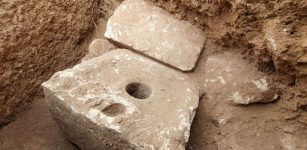Why Did Ancient Egyptian Scribes Face Serious Health Risks?
Conny Waters - AncientPages.com - In ancient Egypt, less than 1% of the population could read and write during the Old Kingdom period. This was primarily due to the absence of a public education system.
The scribes of ancient Egypt played a crucial role in preserving knowledge and history. These highly skilled professionals were trained in various writing systems, including hieroglyphics, hieratic scripts, and the later demotic script, which was particularly useful for commercial and mathematical purposes.
Statues depicting the high dignitary Nefer and his wife (Abusir, Egypt). Credit: Martin Frouz and the Czech Institute of Egyptology, Charles University.
Interestingly, recent research has shed light on the occupational hazards scribes face. Despite their elevated social status, these administrative professionals often suffered from degenerative skeletal changes. These health issues were likely caused by the repetitive nature of their work and the prolonged periods spent in specific seated positions.
Dr. Petra Brukner Havelková and her research team examined the skeletal remains of 69 adult males, of whom 30 were identified as scribes. The remains were excavated from the necropolis at Abusir, Egypt, and date from 2700 to 2180 BCE.
The researchers observed a higher prevalence of degenerative joint changes among scribes compared to individuals in other occupations. These changes were particularly evident in the temporomandibular joints, the right clavicle, the proximal end of the right humerus, the first metacarpal of the right thumb, the distal femur, and throughout the vertebral column, with notable emphasis on the cervical region.
Furthermore, the study identified bone alterations potentially indicative of repetitive stress-induced physical strain in the humerus and left os coxae, which were more frequently observed in scribes than in individuals of other professions.
The research on ancient Egyptian scribes has revealed several interesting findings regarding their physical health and working postures. According to the scientists, the scribes' spines and shoulders exhibited degenerative changes, potentially due to prolonged sitting in a cross-legged position with their heads bent forward, spines flexed, and arms unsupported.
Nikare as a scribe, Old Kingdom, ca. 2420–2389 B.C. or later. Credit: MET - Public Domain
Additionally, observed knee, hip, and ankle changes suggest that scribes may have adopted a specific sitting position. This position likely involved the left leg in a kneeling or cross-legged stance, while the right leg was bent with the knee pointing upwards, resembling a squatting or crouching posture.
The researchers note that various sitting positions, including standing, have been depicted in tomb statues and wall decorations. Furthermore, degeneration in the jaw joints could be attributed to the scribes' chewing rush stems to create brush-like writing implements. The right thumb also showed signs of wear, possibly from repeatedly gripping their writing tools.
These findings provide valuable insights into the daily lives and working conditions of scribes in ancient Egypt during the third millennium B.C., enhancing our understanding of this important historical profession.
The study was published in the journal Scientific Reports
Written by Conny Waters - AncientPages.com Staff Writer






















